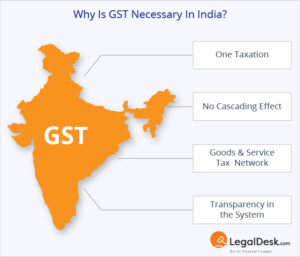Introduction:
The ambitious Goods and Services Tax (GST) was implemented in India on July 1, 2017. A single tax system took the place of a convoluted web of indirect taxes imposed by the federal and state governments. The GST sought to harmonise the tax code, do away with cascading effects, and establish a national single market for goods and services. This blog post examines the main characteristics, advantages, and difficulties of GST, emphasising how it will affect India’s economy.

Understanding GST:
Structure and Implementation
The provision of goods and services is subject to the GST, a comprehensive indirect tax imposed along the whole supply chain. Among other taxes, it has absorbed Central Excise Duty, Service Tax, VAT, and Entry Tax. The central and state governments’ representatives make policy decisions pertaining to GST under the direction of the GST Council.
Dual Model:
GST is levied and managed concurrently by the federal and state governments, according to a dual model. State GST (SGST) is collected by the corresponding state governments, whereas the Central GST (CGST) is collected by the federal government. Additionally, interstate transactions are subject to an Integrated GST (IGST).
Advantages of GST:
Simplification and Ease of Compliance:
GST streamlines compliance processes for businesses by replacing a convoluted tax structure with a single tax framework. The administrative burden on taxpayers has decreased as a result of the elimination of numerous tax filings and the launch of the Goods and Services Tax Network (GSTN), an online portal.
Elimination of Cascading Effect:
The GST’s elimination of the cascading effect of taxes is one of its key advantages. Taxes on taxes used to be imposed, which resulted in greater pricing for customers. GST reduces the cost of products and services by imposing taxes only on the value added at each stage of the supply chain.
Creation of a Common Market:
By reducing interstate restrictions, GST has consolidated the market throughout India. It has made it possible for companies to grow their activities outside of state borders without having to deal with numerous taxes and entry hurdles. This has made it easier for products and services to travel without disruption, fostering economic expansion and lowering logistics expenses.
Boost to Manufacturing and Exports:
The industrial industry has benefited greatly from the introduction of the GST. Input tax credits and the elimination of tax cascades have lowered the cost of production, increasing the competitiveness of Indian goods on the international market. The Make in India effort has benefited from this, as have exports.
Challenges and Criticisms:
Transition and Compliance:
Businesses faced difficulties adjusting to the new tax system during the initial phase of the GST implementation. Changes to IT systems, personnel training, and comprehension of the intricacies of the new tax law were all necessary throughout the transition from the old tax structure to the GST. A seamless deployment was also hampered by technological problems with the GSTN interface and compliance-related problems.
Multiple Tax Slabs:
The existence of various tax slabs is one of the critiques levelled at the GST. Multiple GST rates, including 0%, 5%, 12%, 18%, and 28%, have been criticised for making the tax system more complicated. Critics contend that a less complex tax structure would be easier to comply with and would be less ambiguous if it had fewer rates.
Revenue Collection Challenges:
Due to the lower tax rates on some goods and services, the introduction of the GST initially faced difficulties in collecting taxes. However, as the tax base has grown and compliance has improved over time, revenue collection has gradually increased.
Impact on India’s Economy:
Increased Tax Compliance:
GST has enhanced tax compliance and broadened the tax base. The single tax system
GST has increased the number of enterprises operating in the formal sector. Tax evasion has been more challenging thanks to increased tracking and openness, which has improved tax income collection for the government. India’s fiscal health has improved as a result of the greater tax compliance, and the government now has more funding for development projects.
Boost to Small and Medium Enterprises (SMEs):
The GST has significantly accelerated the development of small and medium-sized businesses. As a result of the GST registration threshold being established at a higher turnover threshold, many small firms are no longer subject to the tax, which lessens their burden of compliance. SMEs can also claim refunds on their purchases thanks to the availability of input tax credits, which lowers their overall tax burden and improves cash flow.
Sectoral Impact:
The establishment of the GST has had a substantial positive impact on several economic sectors. The elimination of interstate checkpoints and the simplification of the documentation procedures, for instance, have increased efficiency and decreased costs in the logistics and supply chain sector. The convenience of conducting business across state lines has also benefited the e-commerce industry, which has improved market penetration and growth.
Foreign Direct Investment (FDI) and Ease of Doing Business:GST’s introduction has increased India’s appeal as a business destination. Foreign businesses now find it simpler to establish operations in India thanks to the country’s unified tax system, streamlined compliance processes, and elimination of various taxes. Increased FDI inflows as a result have strengthened India’s status as a top investment destination and raised the country’s standing in international ease of doing businesrankings.
Rationalization of Indirect Taxes:
Indirect taxes in India have been rationalised and simplified thanks to GST. A harmonised tax structure and the elimination of various tax obstacles have made compliance easier for enterprises to manage, which has enhanced production and efficiency. In addition to improving fairness and lowering tax disputes, this rationalisation has produced a more transparent and equitable tax system.
Conclusion:
An important step towards establishing a uniform and straightforward tax system has been the introduction of the GST in India. GST has demonstrated many advantages and benefits for the Indian economy, despite initial difficulties and objections. It has lowered tax compliance requirements, done away with tax cascades, established a shared market, and increased production and exports. Additionally, it has increased tax compliance, broadened the tax base, and drawn in foreign investment. Overall, GST has been crucial in transforming the Indian economy by promoting expansion, effectiveness, and transparency in the taxing system.
Link:
https://fugentimes.news/?p=8773



































